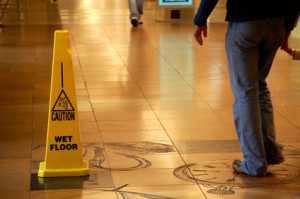
Getting injured in a slip and fall accident at a store is a very common occurrence. It is something for which most business owners prepare and try to avoid through protocols and employee training. However, mistakes are made and accidents happen. The person who is injured as the result of someone else’s mistake is entitled to compensation to pay for the harm that was done and the economic losses that were suffered as a result of the slip and fall injury. The fact that the negligent party was a store does not make it any less responsible.
The store has an obligation to create a safe environment for its patrons. When the business fails to meet this standard and a customer is harmed, then the store must pay for the harm that it has caused. In order to prove that a store is liable for the harm that was done, a victim must prove:
- The business owed a duty of care to the customer;
- The business, through the actions of one of its managers or employees, breached that duty of care;
- The breach was the cause of the harm suffered by the customer; and
- The customer experienced actual harm. Usually, this harm is physical, but an emotional injury may qualify under certain circumstances.
In order to be successful in a legal action, the customer must prove each element. Proving that a store has a duty of care is fairly easy if the store opened its doors and welcomed customers. Although the store cannot be expected to prevent every possible hazard, the business does need to meet the standard that it performed its obligations in a manner that another business of the same size and nature would reasonably have done. This may relate to regular cleaning and inspections, clear warnings of potential hazards, placement of mats or rugs where there is a likelihood of water intrusion or other slippery conditions, for instance around entrances, and proper maintenance of the areas surrounding the store. If the business breaches this duty by failing to perform these obligations in a timely and effective manner, then it may be liable for the harm caused.
Once a customer has shown that the business owed him a duty of care, breached that duty, and the customer was harmed as a result of that breach, the customer is entitled to recover damages for:
- Medical bills and reasonably anticipated medical expenses related to the injury in the future;
- Lost wages;
- Loss of future earning capacity;
- Pain and suffering; and
- Miscellaneous expenses related to the accident and injury.
The critical step that we have skipped over is proving that the injury was the result of the breach. There needs to be a direct causal relationship between the failure of the business and the harm suffered by the customer. A patron who fell in the entrance on a wet day may recover if he slipped on a patch of water that should have been cleaned up or resolved with a mat. However, if that customer actually tripped when he got tangled up in the stroller he was pushing, then winning the case is not very likely.
It is true that there are times when a customer was at fault and the injury is not the responsibility of the business. Many times, though, the store and its insurance provider will try to avoid payment by improperly casting blame on the customer or will attempt to bully the customer into accepting a small settlement that does not begin to cover the harm that was suffered. The expert attorneys at Lundy Law know how to prove that the store was at fault and get victims the compensation that they deserve. We are so committed to this goal that we only get paid if we win your case, through our No Fee Assurance. Please call us today at 1-800-LundyLaw or fill out our free online consultation form to discuss your case. We are ready to fight for you now.
















